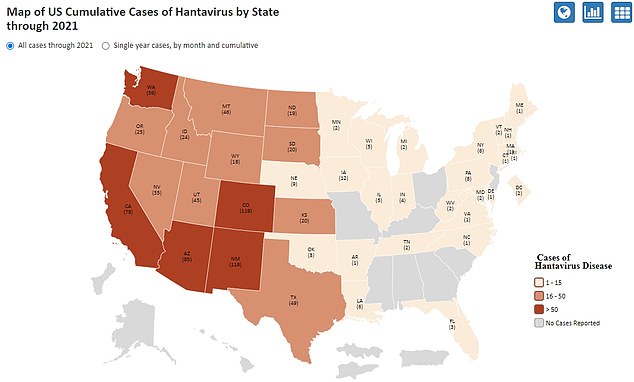Authorities have issued a health warning about an incurable disease affecting rats after four people died from the infection this year.
Hantavirus, which is fatal in 36 percent of cases, typically causes about 30 cases per year in the United States, primarily in the West and Southwest.
But some states are now seeing a surge in the disease.
In Arizona, a hotspot of infection, authorities have issued a warning after recording seven cases and three deaths this year, compared with 11 cases in the six years from 2016 to 2022.
There have also been two cases and one death in California, including in a county that has not detected the virus for two decades.
The map above shows hantavirus cases by state from 1993 to 2021. Colorado and New Mexico are the main hotspots.
Recent extreme temperatures coupled with heavy rainfall are thought to be driving a surge in infections in some areas, as this leads virus-carrying rodents to seek shelter from the heat and rain indoors, where they come into contact with humans.
Heavy rains can also stimulate plant growth and food supply for rodents, leading to increased rodent activity and, subsequently, a possible increase in their population.
Arizona health officials said: ‘Hantavirus is a serious and sometimes fatal respiratory illness.
“It’s not limited to one geographic location. It can be present in many areas of the southwestern United States where there is rodent activity, even if mice are never seen.”
Rats and mice can carry hantavirus but not show any symptoms.
But they can shed it in their feces, saliva and urine, and humans can inhale the virus if they touch contaminated surfaces.
Patients initially experience an abrupt onset of fever, muscle aches, nausea and abdominal pain between nine and 33 days after infection.

Hantavirus is transmitted by rodents such as the deer mouse (pictured). It does not cause symptoms in rodents, but can be transmitted through urine or saliva.
But this then progresses to difficulty breathing in a condition called hantavirus lung disease.
In this case, the virus infects the cells lining the tiny blood vessels in the lungs, causing them to start leaking and filling the lungs with fluid. Death results from respiratory failure or shock.
There are no specific treatments for this disease; doctors rely on intravenous drips and over-the-counter medications to relieve symptoms.
Colorado and New Mexico are home to the largest number of hantavirus infections, with each having recorded 119 cases since 1993.
Arizona has the third-highest count, with 85 cases, followed by California, 78 cases, and Washington, 59 cases.
In April, a person in Sierra County, California, died from hantavirus — the first case in the area in more than two decades.
Officials said at the time: “Although rare, hantavirus can be very serious and fatal.”
‘About three cases of hantavirus disease are reported in California each year, and about one in three people with hantavirus disease die.’
There is concern that the disease could be diagnosed in new areas more frequently as rising temperatures cause changes in the rodents’ locations.

